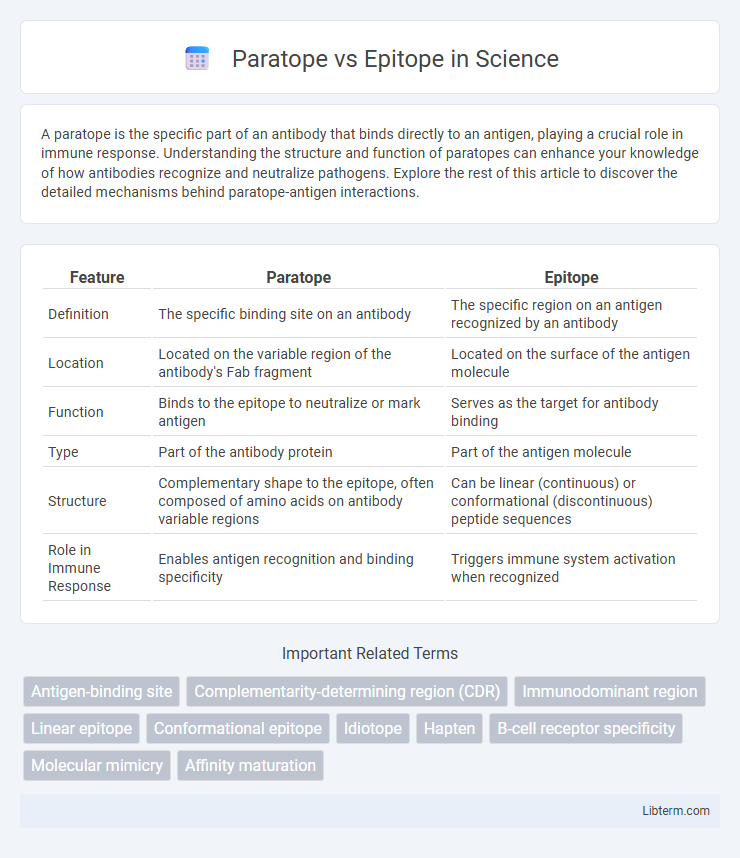A paratope is the specific part of an antibody that binds directly to an antigen, playing a crucial role in immune response. Understanding the structure and function of paratopes can enhance your knowledge of how antibodies recognize and neutralize pathogens. Explore the rest of this article to discover the detailed mechanisms behind paratope-antigen interactions.
Table of Comparison
| Feature | Paratope | Epitope |
|---|---|---|
| Definition | The specific binding site on an antibody | The specific region on an antigen recognized by an antibody |
| Location | Located on the variable region of the antibody's Fab fragment | Located on the surface of the antigen molecule |
| Function | Binds to the epitope to neutralize or mark antigen | Serves as the target for antibody binding |
| Type | Part of the antibody protein | Part of the antigen molecule |
| Structure | Complementary shape to the epitope, often composed of amino acids on antibody variable regions | Can be linear (continuous) or conformational (discontinuous) peptide sequences |
| Role in Immune Response | Enables antigen recognition and binding specificity | Triggers immune system activation when recognized |
Introduction to Paratope and Epitope
Paratopes are specific regions on an antibody that recognize and bind to epitopes, which are distinct molecular sites on antigens. The interaction between paratope and epitope is critical for immune recognition and antibody specificity. Understanding the structural and functional differences between paratopes and epitopes is essential for antibody design and vaccine development.
Defining Paratope: The Antibody’s Binding Site
The paratope is the specific region on an antibody responsible for recognizing and binding to an antigen's epitope. This binding site consists of variable amino acid sequences within the antibody's variable regions, allowing precise interaction with the epitope's unique molecular structure. Understanding the paratope's configuration is crucial for antibody specificity and therapeutic antibody design.
Understanding Epitope: The Antigen’s Recognizable Region
The epitope is the specific part of an antigen molecule that is recognized and bound by an antibody's paratope during an immune response. This antigenic determinant typically consists of a short sequence of amino acids or a conformational structure on the protein surface, enabling precise immune targeting. Understanding epitopes is crucial for vaccine design, antibody engineering, and immunodiagnostics by highlighting the molecular interface for antigen-antibody interaction.
Structural Differences: Paratope vs Epitope
Paratopes are the specific binding sites located on the variable region of an antibody, typically composed of amino acid residues that form a complementary shape to the antigen. Epitopes are distinct structural regions on the surface of an antigen recognized by the paratope, often characterized by specific amino acid sequences and conformations that enable antibody binding. The structural difference lies in the paratope's adaptability and variability to bind diverse epitopes, while epitopes provide unique molecular patterns that determine antibody specificity.
Functional Roles in Immune Response
Paratopes are the specific regions on an antibody that recognize and bind to epitopes, which are the distinct antigenic sites on pathogens. The paratope-epitope interaction is crucial for the immune system to identify and neutralize foreign invaders, triggering immune responses such as opsonization and complement activation. This precise molecular recognition enables targeted immune defense, facilitating pathogen clearance and memory cell formation.
Mechanisms of Paratope-Epitope Interaction
Paratopes are specific antigen-binding sites located on the variable region of an antibody, directly recognizing and binding to epitopes, which are distinct molecular regions on the antigen surface. The interaction mechanism relies on complementary shapes, charge distributions, and hydrophobic or hydrogen bonding affinities between the paratope's amino acid residues and the epitope structure. This precise molecular fit triggers immune responses by facilitating antigen recognition, neutralization, and subsequent activation of immune effector pathways.
Importance in Vaccine Development
Paratopes and epitopes play a critical role in vaccine development by determining the specificity of immune recognition; paratopes are the antibody regions that bind directly to epitopes, which are the precise antigen segments targeted by the immune system. Understanding the structural and biochemical characteristics of epitopes enables the design of vaccines that elicit strong and specific antibody responses through paratope engagement. This precise interaction enhances vaccine efficacy by promoting immune memory and neutralizing pathogens effectively.
Applications in Diagnostic Immunology
Paratopes, the antigen-binding sites on antibodies, specifically recognize epitopes, the distinct molecular regions on antigens, enabling precise detection in diagnostic immunology. High-affinity paratope-epitope interactions are exploited in assays such as ELISA, immunohistochemistry, and flow cytometry to identify pathogens, biomarkers, and disease-associated antigens with great sensitivity and specificity. Custom-engineered paratopes improve diagnostic accuracy by targeting unique epitopes, facilitating early disease diagnosis and personalized medicine approaches.
Challenges in Mapping Paratope-Epitope Relationships
Mapping paratope-epitope relationships faces challenges due to the structural complexity and conformational flexibility of antibodies and antigens, which complicate accurate identification of binding sites. High-resolution techniques like X-ray crystallography and cryo-EM require extensive resources and may not capture dynamic interactions in physiological conditions. Computational prediction models struggle with variability in amino acid sequences and epitope accessibility, limiting their reliability in defining precise paratope-epitope interactions.
Future Perspectives in Antibody-Antigen Research
Advancements in structural biology and machine learning are revolutionizing the understanding of paratopes and epitopes, enabling precise mapping of antibody-antigen interactions at atomic resolution. Future research emphasizes engineering paratopes with enhanced specificity and affinity, facilitating next-generation therapeutics and personalized vaccines. Integration of computational modeling with high-throughput screening accelerates the discovery of novel epitopes, driving innovations in immunotherapy and infectious disease management.
Paratope Infographic

 libterm.com
libterm.com